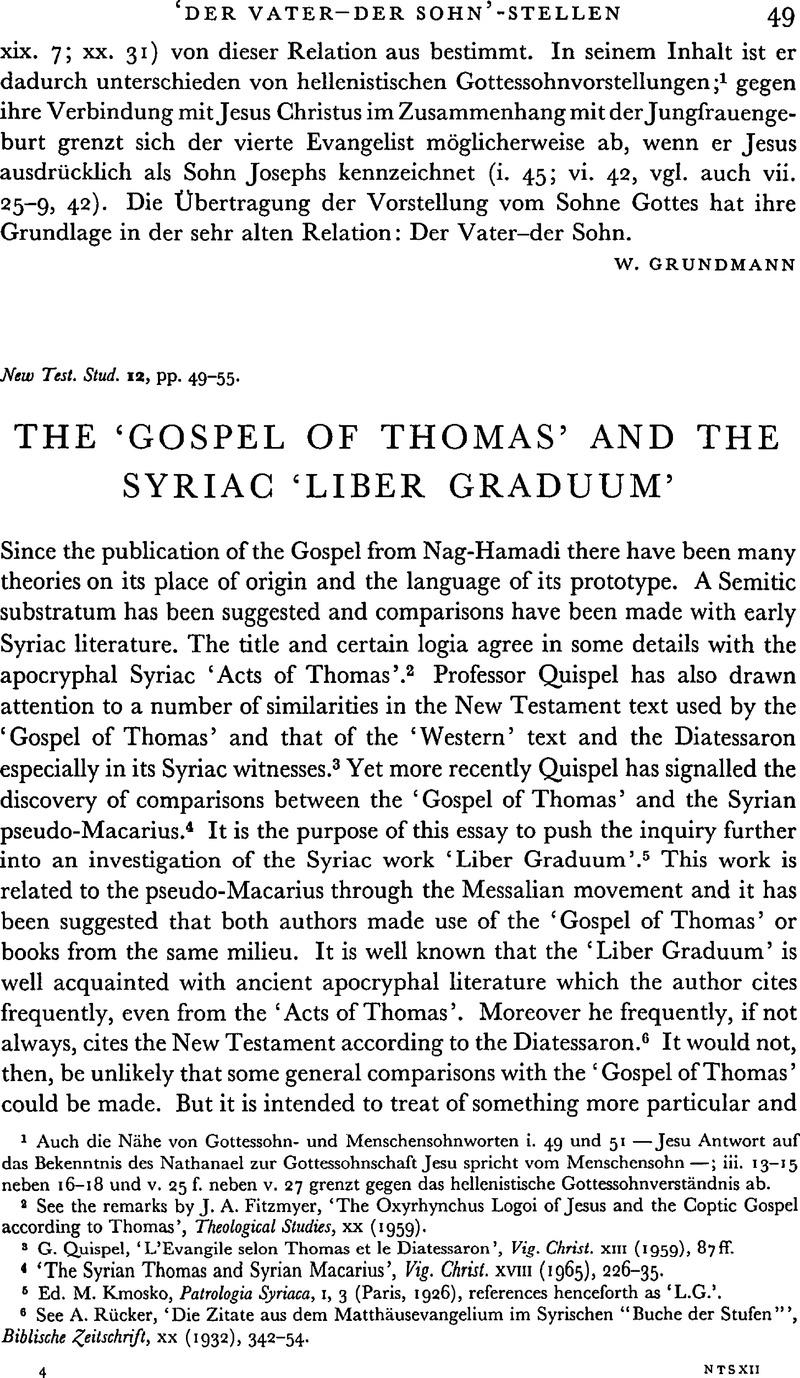Published online by Cambridge University Press: 05 February 2009

page 49 note 1 Auch die Nähe von Gottessohn- und Menschensohnworten, i. 49 und 51Google Scholar — Jesu Antwort auf das Bekenntnis des Nathanael zur Gottessohnschaft Menschensohn, Jesu spricht vom —; iii. 13–15Google Scholarnebhen, 16–18Google Scholar und v. 25 f. nebhen, v. 27Google Scholar grenzt gegen das hellenistiche Gottessohnverständnis ab.
page 49 note 2 See the remarks by Fitzmyer, J. A., ‘The Oxyrhynchus Logoi of Jesus and the Coptic Gospel according to Thomas’, Theological Studies, xx (1959).Google Scholar
page 49 note 3 Quispel, G., ‘L'Evangile selon Thomas et le Diatessaron’, Vig. Christ. XIII (1959), 87ff.CrossRefGoogle Scholar
page 49 note 4 ‘The Syrian Thomas and Syrian Macarius’, Vig. Christ. XVIII (1965), 226–35.Google Scholar
page 49 note 5 ed. Kmosko, M., Patrologia Syriaca, 1, 3 (Paris, 1926Google Scholar), references henceforth as ‘L.G.’.
page 49 note 6 See Rücker, A., ‘Die Zitate aus dem Matthäusevangelium im Syrischen “Buche der Stufen”’, Biblische Zeitschrift, xx (1932), 342–54.Google Scholar
page 50 note 1 The translation and division of the logia of the ‘Gospel of Thomas’ (= G.T.) is from Metzger, B. M., in the appendix to Synopsis Quattuor Evangeliorum, ed. by Aland, K..Google Scholar
page 50 note 2 L.G., 373, 18–19; 373, 23–4Google Scholar; 828, 13. My own article ‘Fasting to the World’ to be published in J.B.L. deals with this question in greater detail. It was composed quite independently and without knowledge of Guillaumont, A., ‘Nηστεύἕν τòν κόσμων’, Bulletin de l' Institut Français d' Archéologie Orientale, LXI (1962), 15–23.Google Scholar
page 50 note 3 Strom. III, 92, 2.Google Scholar
page 50 note 4 ed. Tischendorf, C., Acta Apostolorum Apocrypha, 34.Google Scholar
page 50 note 5 Ed. and tr. Cantanzaro, C. J. de, J.T.S. (1962), 51.Google Scholar
page 50 note 6 9, 94; Acta Petri cum Simone 38, 95.Google Scholar
page 50 note 7 ed. Beeson, C. H., G.C.S. (Leipzig, 1906), 6, 13.Google Scholar
page 51 note 1 See Origen, Contra Celsum, 1, 28Google Scholar and cf. Grant, R. M. with Freedman, David Noel, The Secret Sayings of Jesus (London, 1960), p. 77.Google Scholar
page 51 note 2 See Connolly, R. H., ‘A negative form of the Golden Rule in the Diatessaron?’, J.T.S. xxxv (1934), 351–7.Google Scholar
page 51 note 3 Op. cit. p. 74Google Scholar
page 53 note 1 Guillaumont, A., ‘Sémitismes dans les logia de Jésus retrouvés a Nag Hamadi’, Journal Asiatique, CCXLVII (1958).Google Scholar
page 53 note 2 See Schrage, W., Das Verhältnis des Thomas-Evangeliums zur synoptischen Tradition und zu den koptischen Evangelienübersetzungen (Berlin, 1964), pp. 179–80Google Scholar giving Basil, Chrysostom and Hippolytus for the omission.
page 53 note 3 See Grant, and Freedman, , op. cit. p. 175.Google Scholar
page 55 note 1 See Vööbus, A., Celibacy, a Requirement for Admission to Baptism in the Early Syrian Church (Papers of the Estonian Theological Society in exile, I) (Stockholm, 1951), p. 19Google Scholar for frequent use of this Diatessaron reading in an encratitic sense.
page 55 note 2 Quispel, , art. cit. V.C. XVIII (1965)Google Scholar, suggests that L.G. as also pseudo-Macarius may have been actually citing G.T. This of course would have to proved. In the case of L.G. there does not seem sufficient evidence of a direct dependence.